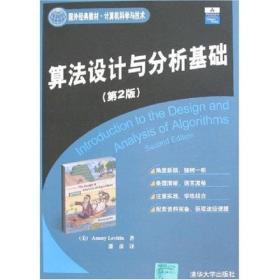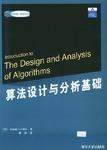
算法设计与分析基础
¥ 65 8.2折 ¥ 79 全新
仅1件
广东广州
认证卖家担保交易快速发货售后保障
作者[美]Anany Levitin 著
出版社清华大学出版社
出版时间2013-05
版次3
装帧平装
货号58944103
上书时间2025-01-06
- 最新上架
商品详情
- 品相描述:全新
图书标准信息
- 作者 [美]Anany Levitin 著
- 出版社 清华大学出版社
- 出版时间 2013-05
- 版次 3
- ISBN 9787302311850
- 定价 79.00元
- 装帧 平装
- 开本 16开
- 纸张 胶版纸
- 页数 596页
- 字数 1047千字
- 正文语种 英语
- 原版书名 Introduction to the Design and Analysis of Algorithms
- 【内容简介】
-
《算法设计与分析基础 (第3版)(影印版)》在讲述算法设计技术时采用了新的分类方法,在讨论分析方法时条分缕析,形成了连贯有序、耳目一新的风格。为便于学生掌握,本书涵盖算法入门课程的全部内容,更注重对概念(而非形式)的理解。书中通过一些流行的谜题来激发学生的兴趣,帮助他们加强和提高解决算法问题的能力。每章小结、习题提示和详细解答,形成了非常鲜明的教学特色。
- 【作者简介】
-
Anany Levitin博士,美国维拉诺瓦大学教授,毕业于莫斯科国立大学并获得数学硕士学位。他拥有耶路撒冷希伯来大学数学博士学位和美国肯塔基大学计算机科学硕士学位。他的著作《算法设计与分析基础》已经被翻译为中文、俄文、希腊文和韩文,并被全球数百所高校广泛用作教材。目前,Levitin博士在美国维拉诺瓦大学讲授“算法设计与分析”课程。他的另一本著作《算法谜题》已经于2011年秋出版。
Anany Levitin,美籍犹太人,维拉诺瓦大学(Villanova)计算机科学系教授。他的论文“算法设计技术新途径:弥补传统分类法的缺憾”(A New Road Mpa of Algorithm Design Techniques: Picking Up Where the Traditional Classfication Leaves Off)深受业内好评,并享有广泛的声誉。他提出的这种新分类方法涵盖众多经典算法,开创了传统分类无法以一致方式介绍这些算法的先河。作为通用的问题解决工具,算法设计技术的应用很广,尤其适用于解决“狼,羊,白菜”问题和旅行商问题之类的流行谜题。
因为他对算法教育所做出的杰出贡献,Levitin教授曾多次受邀在SIGCSE(Computer Science Education,计算机教育) 全球大会上发表演讲,此大会每三年才举行一次。
Anany Levitin教授目前的研究课题为“Do We Teach the Right Algorithm Design Techniques ?”
- 【目录】
-
New to the Third Edition xvii
Preface xix
1Introduction
1.1 What Is an Algorithm?
Exercises 1.1
1.2 Fundamentals of Algorithmic Problem Solving
Understanding the Problem
Ascertaining the Capabilities of the Computational Device
Choosing between Exact and Approximate Problem Solving
Algorithm Design Techniques
Designing an Algorithm and Data Structures
Methods of Specifying an Algorithm
Proving an Algorithm's Correctness
Analyzing an Algorithm
Coding an Algorithm
Exercises 1.2
1.3 Important Problem Types
Sorting
Searching
String Processing
Graph Problems
Combinatorial Problems
Geometric Problems
Numerical Problems
Exercises 1.3
1.4 Fundamental Data Structures
Linear Data Structures
Graphs
Trees
Sets and Dictionaries
Exerises 1.4
Summary
2 Fundamentals of the Analysis of Algorithm Efficiency
2.1 The Analysis Framework
Measuring an Input's Size
Units for Measuring Running Time
Orders of Growth
Worst-Case, Best-Case, and Average-Case Efficiencies
Recapitulation of the Analysis Framework
Exercises 2.1
2.2 Asymptotic Notations and Basic Efficiency Classes
Informal Introduction
O-notation
-notation
-notation
Useful Property Involving the Asymptotic Notations
Using Limits for Comparing Orders of Growth
Basic Efficiency Classes
Exercises 2.2
2.3 Mathematical Analysis of Nonrecursive Algorithms
Exercises 2.3
2.4 Mathematical Analysis of Recursive Algorithms
Exercises 2.4
2.5 Example: Computing the nth Fibonacci Number
Exercises 2.5
2.6 Empirical Analysis of Algorithms
Exercises 2.6
2.7 Algorithm Visualization
Summary
3 Brute Force and Exhaustive Search
3.1 Selection Sort and Bubble Sort
Selection Sort
Bubble Sort
Exercises 3.1
3.2 Sequential Search and Brute-Force String Matching
Sequential Search
Brute-Force String Matching
Exercises 3.2
3.3 Closest-Pair and Convex-Hull Problems by Brute Force
Closest-Pair Problem
Convex-Hull Problem
Exercises 3.3
3.4 Exhaustive Search
Traveling Salesman Problem
Knapsack Problem
Assignment Problem
Exercises 3.4
3.5 Depth-First Search and Breadth-First Search
Depth-First Search
Breadth-First Search
Exercises 3.5
Summary
4 Decrease-and-Conquer
4.1 Insertion Sort
Exercises 4.1
4.2 Topological Sorting
Exercises 4.2
4.3 Algorithms for Generating Combinatorial Objects
Generating Permutations
Generating Subsets
Exercises 4.3
4.4 Decrease-by-a-Constant-Factor Algorithms
Binary Search
Fake-Coin Problem
Russian Peasant Multiplication
Josephus Problem
Exercises 4.4
4.5 Variable-Size-Decrease Algorithms
Computing a Median and the Selection Problem
Interpolation Search
Searching and Insertion in a Binary Search Tree
The Game of Nim
Exercises 4.5
Summary
5 Divide-and-Conquer
5.1 Mergesort
Exercises 5.1
5.2 Quicksort
Exercises 5.2
5.3 Binary Tree Traversals and Related Properties
Exercises 5.3
5.4 Multiplication of Large Integers and
Strassen's Matrix Multiplication
Multiplication of Large Integers
Strassen's Matrix Multiplication
Exercises 5.4
5.5 The Closest-Pair and Convex-Hull Problems
by Divide-and-Conquer
The Closest-Pair Problem
Convex-Hull Problem
Exercises 5.5
Summary
6 Transform-and-Conquer
6.1 Presorting
Exercises 6.1
6.2 Gaussian Elimination
LU Decomposition
Computing a Matrix Inverse
Computing a Determinant
Exercises 6.2
6.3 Balanced Search Trees
AVL Trees
2-3 Trees
Exercises 6.3
6.4 Heaps and Heapsort
Notion of the Heap
Heapsort
Exercises 6.4
6.5 Horner's Rule and Binary Exponentiation
Horner's Rule
Binary Exponentiation
Exercises 6.5
6.6 Problem Reduction
Computing the Least Common Multiple
Counting Paths in a Graph
Reduction of Optimization Problems
Linear Programming
Reduction to Graph Problems
Exercises 6.6
Summary
7 Space and Time Trade-Offs
7.1 Sorting by Counting
Exercises 7.1
7.2 Input Enhancement in String Matching
Horspool's Algorithm
Boyer-Moore Algorithm
Exercises 7.2
7.3 Hashing
Open Hashing (Separate Chaining)
Closed Hashing (Open Addressing)
Exercises 7.3
7.4 B-Trees
Exercises 7.4
Summary
8 Dynamic Programming
8.1 Three Basic Examples
Exercises 8.1
8.2 The Knapsack Problem and Memory Functions
Memory Functions
Exercises 8.2
8.3 Optimal Binary Search Trees
Exercises 8.3
8.4 Warshall's and Floyd's Algorithms
Warshall's Algorithm
Floyd's Algorithm for the All-Pairs Shortest-Paths Problem
Exercises 8.4
Summary
9 Greedy Technique
9.1 Prim's Algorithm
Exercises 9.1
9.2 Kruskal's Algorithm
Disjoint Subsets and Union-Find Algorithms
Exercises 9.2
9.3 Dijkstra's Algorithm
Exercises 9.3
9.4 Huffman Trees and Codes
Exercises 9.4
Summary
10 Iterative Improvement
10.1 The Simplex Method
Geometric Interpretation of Linear Programming
An Outline of the Simplex Method
Further Notes on the Simplex Method
Exercises 10.1
10.2 The Maximum-Flow Problem
Exercises 10.2
10.3 Maximum Matching in Bipartite Graphs
Exercises 10.3
10.4 The Stable Marriage Problem
Exercises 10.4
Summary
11 Limitations of Algorithm Power
11.1 Lower-Bound Arguments
Trivial Lower Bounds
Information-Theoretic Arguments
Adversary Arguments
Problem Reduction
Exercises 11.1
11.2 Decision Trees
Decision Trees for Sorting
Decision Trees for Searching a Sorted Array
Exercises 11.2
11.3 P, NP, and NP-Complete Problems
P and NP Problems
NP-Complete Problems
Exercises 11.3
11.4 Challenges of Numerical Algorithms
Exercises 11.4
Summary
12 Coping with the Limitations of Algorithm Power
12.1 Backtracking
n-Queens Problem
Hamiltonian Circuit Problem
Subset-Sum Problem
General Remarks
Exercises 12.1
12.2 Branch-and-Bound
Assignment Problem
Knapsack Problem
Traveling Salesman Problem
Exercises 12.2
12.3 Approximation Algorithms for NP-Hard Problems
Approximation Algorithms for the Traveling Salesman Problem
Approximation Algorithms for the Knapsack Problem
Exercises 12.3
12.4 Algorithms for Solving Nonlinear Equations
Bisection Method
Method of False Position
Newton's Method
Exercises 12.4
Summary
Epilogue
APPENDIX A
Useful Formulas for the Analysis of Algorithms
Properties of Logarithms
Combinatorics
Important Summation Formulas
Sum Manipulation Rules
Approximation of a Sum by a Definite Integral
Floor and Ceiling Formulas
Miscellaneous
APPENDIX B
Short Tutorial on Recurrence Relations
Sequences and Recurrence Relations
Methods for Solving Recurrence Relations
Common Recurrence Types in Algorithm Analysis
References
Hints to Exercises
Index
点击展开
点击收起
相关推荐
— 没有更多了 —



















以下为对购买帮助不大的评价